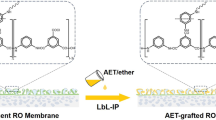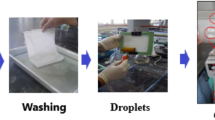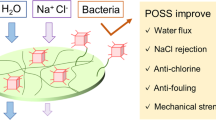Abstract
The lifespan of reverse osmosis (RO) membranes is only several months when used for industrial wastewater treatment rather than several years for seawater desalination, dramatically increasing the maintenance cost of RO. Here, to improve the separation and anti-fouling performance and thus increase the lifespan of RO membranes, we developed a creative strategy to methylate RO membranes via grafting gaseous dimethylamine molecules onto polyamide (PA) of RO membrane during interfacial polymerization. The dimethylamine-grafted RO membrane achieved a high water permeance of 3.84 l m−2 h−1 bar−1 and a high NaCl rejection of 99.05% and exhibited unprecedented anti-fouling performance against small organic charged foulants, surpassing the upper-bound threshold of the other reported anti-fouling membranes and the well-known commercial anti-fouling RO membrane (DuPont FilmTec Fortilife CR100). Both experimental results and molecular dynamics simulation findings illustrate that the methylated PA has a lower absorption energy with small charged organic foulants than the pristine PA, which alleviates the foulantsʼ absorption with a lower areal density and a looser packing, and a much shallower penetration depth inside PA. Our work suggests that avoiding penetration of foulants inside PA and preventing pore blocking of PA by foulants are essential to improve the fouling resistance of RO membranes. This work contributes a new outlook on the RO membrane-fouling mechanism from the molecular levels using molecular dynamics simulation and also develops a simple and effective methylation approach to enhance the RO membrane-fouling resistance towards small charged foulants.
This is a preview of subscription content, access via your institution
Access options
Subscribe to this journal
Receive 12 digital issues and online access to articles
118,99 € per year
only 9,92 € per issue
Buy this article
- Purchase on SpringerLink
- Instant access to full article PDF
Prices may be subject to local taxes which are calculated during checkout






Similar content being viewed by others
Data availability
The main data supporting the findings of this study are contained within the paper. Key experimental datasets and source files for figures and extended data are attached as Supplementary Information. All other relevant data are available from the corresponding author upon reasonable request.
Code availability
All codes written for and used in this study are available from the corresponding author upon reasonable request.
Change history
31 January 2025
A Correction to this paper has been published: https://doi.org/10.1038/s44221-025-00396-w
References
Elimelech, M. & Phillip, W. A. The future of seawater and the environment. Science 333, 712–717 (2011).
Shen, L. et al. Polyamide-based membranes with structural homogeneity for ultrafast molecular sieving. Nat. Commun. 13, 500 (2022).
Hu, Y. Grand challenge in membrane applications: liquid. Front. Membr. Sci. Tech. 2, 1177528 (2023).
Yao, Y. et al. High performance polyester reverse osmosis desalination membrane with chlorine resistance. Nat. Sustain. 4, 138–146 (2021).
Liu, C. et al. Separation, anti-fouling, and chlorine resistance of the polyamide reverse osmosis membrane: from mechanisms to mitigation strategies. Water Res. 195, 116976 (2021).
Eke, J. et al. The global status of desalination: an assessment of current desalination technologies, plants and capacity. Desalination 495, 114633 (2020).
Culp, T. E. et al. Nanoscale control of internal inhomogeneity enhances water transport in desalination membranes. Science 371, 72–75 (2021).
Giammar, D. E., Greene, D. M. & Mishrra, A. Cost and energy metrics for municipal water reuse. ACS ES&T Eng. 2, 489–507 (2021).
Geise, G. M. Why polyamide reverse-osmosis membranes work so well. Science 371, 31–32 (2021).
Jafari, M. et al. Cost of fouling in full-scale reverse osmosis and nanofiltration installations in the Netherlands. Desalination 500, 114865 (2021).
Zhang, R. et al. Antifouling membranes for sustainable water purification: strategies and mechanisms. Chem. Soc. Rev. 45, 5888–5924 (2016).
Deng, L. et al. Fabrication of antifouling thin-film composite nanofiltration membrane via surface grafting of polyethyleneimine followed by zwitterionic modification. J. Membr. Sci. 619, 118564 (2021).
Zhang, S. et al. Optimization and organic fouling behavior of zwitterion-modified thin-film composite polyamide membrane for water reclamation: a comprehensive study. J. Membr. Sci. 596, 117748 (2020).
Jiang, S., Li, Y. & Ladewig, B. P. A review of reverse osmosis membrane fouling and control strategies. Sci. Total Environ. 595, 567–583 (2017).
Into, M., Jönsson, A. S. & Lengdén, G. Reuse of industrial wastewater following treatment with reverse osmosis. J. Membr. Sci. 242, 21–25 (2004).
Landaburu-Aguirre, J. et al. Fouling prevention, preparing for re-use and membrane recycling. Towards circular economy in RO desalination. Desalination 393, 16–30 (2016).
Lu, X. & Elimelech, M. Fabrication of desalination membranes by interfacial polymerization: history, current efforts, and future directions. Chem. Soc. Rev. 50, 6290–6307 (2021).
Habib, S. & Weinman, S. T. A review on the synthesis of fully aromatic polyamide reverse osmosis membranes. Desalination 502, 114939 (2021).
Mo, Y. et al. Improved antifouling properties of polyamide nanofiltration membranes by reducing the density of surface carboxyl groups. Environ. Sci. Technol. 46, 13253–13261 (2012).
Li, S. L. et al. Construction of pseudo-zwitterionic polyamide RO membranes surface by grafting positively charged small molecules. Desalination 537, 115892 (2022).
Guan, Y. et al. Preparation of antifouling TFC RO membranes by facile grafting zwitterionic polymer PEI-CA. Desalination 539, 115972 (2022).
Qin, Y. et al. Impact of end groups of small molecules grafted to reverse osmosis membranes on their separation and antifouling performance. Desalination 586, 117864 (2024).
Zhao, Q. et al. Construction of tunable “silica molecular brush” on the polyamide membrane surface for enhancing water permeability and antifouling performance. Desalination 554, 116521 (2023).
Xiao, J. et al. Fouling-resistant reverse osmosis membranes grafted with 2-aminoethanethiol having a low interaction energy with charged foulants. npj Clean Water 33, 1 (2024).
Liu, M. et al. In situ modification of polyamide reverse osmosis membrane module for improved fouling resistance. Chem. Eng. Res. Des. 141, 402–412 (2019).
Xu, J., Wang, Z., Wang, J. & Wang, S. Positively charged aromatic polyamide reverse osmosis membrane with high anti-fouling property prepared by polyethylenimine grafting. Desalination 365, 398–406 (2015).
Wu, J. et al. Polyvinylamine-grafted polyamide reverse osmosis membrane with improved antifouling property. J. Membr. Sci. 495, 1–13 (2015).
Yi, Z. et al. Chemical grafting N-GOQD of polyamide reverse osmosis membrane with improved chlorine resistance, water flux and NaCl rejection. Desalination 479, 114341 (2020).
Xu, R. et al. Enhancing the chlorine stability and antifouling properties of thin-film composite reverse osmosis membranes via surface grafting L-arginine-functionalized polyvinyl alcohol. Ind. Eng. Chem. Res. 59, 10882–10893 (2020).
Shen, L. & Wang, Y. Efficient surface modification of thin-film composite membranes with self-catalyzed tris(2-aminoethyl) amine for forward osmosis separation. Chem. Eng. Sci. 178, 82–92 (2018).
Zhang, X. et al. Facile dual-functionalization of polyamide reverse osmosis membrane by a natural polypeptide to improve the antifouling and chlorine-resistant properties. J. Membr. Sci. 604, 118044 (2020).
Zhao, C. et al. Polyamide membranes with nanoscale ordered structures for fast permeation and highly selective ion–ion separation. Nat. Commun. 14, 1112 (2023).
Lu, D. et al. Constructing a selective blocked-nanolayer on nanofiltration membrane via surface-charge inversion for promoting Li+ permselectivity over Mg2+. J. Membr. Sci. 635, 119504 (2021).
Shi, M. et al. Solvent activation before heat-treatment for improving reverse osmosis membrane performance. J. Membr. Sci. 595, 117565 (2020).
Liu, Z. Y. et al. Understanding the antifouling mechanism of zwitterionic monomer-grafted polyvinylidene difluoride membranes: a comparative experimental and molecular dynamics simulation study. ACS Appl. Mater. Interfaces 11, 14408–14417 (2019).
Liu, Z., Qi, L., An, X., Liu, C. & Hu, Y. Surface engineering of thin film composite polyamide membranes with silver nanoparticles through layer-by-layer interfacial polymerization for antibacterial properties. ACS Appl. Mat. Inter. 9, 40987–40997 (2017).
Lin, J. et al. Shielding effect enables fast ion transfer through nanoporous membrane for highly energy-efficient electrodialysis. Nat. Water 1, 725–735 (2023).
Zhao, G., Gao, H., Qu, Z., Fan, H. & Meng, H. Anhydrous interfacial polymerization of sub-1 Å sieving polyamide membrane. Nat. Commun. 14, 7624 (2023).
Guan, K. et al. Deformation constraints of graphene oxide nanochannels under reverse osmosis. Nat. Commun. 14, 1016 (2023).
Tiraferri, A. & Elimelech, M. Direct quantification of negatively charged functional groups on membrane surfaces. J. Membr. Sci. 389, 499–508 (2012).
Do, V. T., Tang, C. Y., Reinhard, M. & Leckie, J. O. Degradation of polyamide nanofiltration and reverse osmosis membranes by hypochlorite. Environ. Sci. Technol. 46, 852–859 (2012).
Nieuwendaal, R. C. et al. A method to quantify composition, purity, and cross-link density of the active polyamide layer in reverse osmosis composite membranes using 13C cross polarization magic angle spinning nuclear magnetic resonance spectroscopy. J. Membr. Sci. 648, 120346 (2022).
Teng, M. Y. et al. Plasma deposition of acrylamide onto novel aromatic polyamide membrane for pervaporation. Eur. Polym. J. 36, 663–672 (2000).
Aston, J. G., Eidinoff, M. L. & Forster, W. S. The heat capacity and entropy, heats of fusion and vaporization and the vapor pressure of dimethylamine. J. Am. Chem. Soc. 61, 1539–1543 (1939).
Li, Y. et al. Loosening ultrathin polyamide nanofilms through alkali hydrolysis for high-permselective nanofiltration. J. Membr. Sci. 637, 119623 (2021).
Xu, J., Yan, H., Zhang, Y., Pan, G. & Liu, Y. The morphology of fully-aromatic polyamide separation layer and its relationship with separation performance of TFC membranes. J. Membr. Sci. 541, 174–188 (2017).
Liu, C., Faria, A. F., Ma, J. & Elimelech, M. Mitigation of biofilm development on thin-film composite membranes functionalized with zwitterionic polymers and silver nanoparticles. Environ. Sci. Technol. 51, 182–191 (2017).
Yuan, B., Zhao, S., Hu, P., Cui, J. & Niu, Q. J. Asymmetric polyamide nanofilms with highly ordered nanovoids for water purification. Nat. Commun. 11, 6102 (2020).
Nikkola, J. et al. Surface modification of thin film composite polyamide membrane using atomic layer deposition method. J. Membr. Sci. 450, 174–180 (2014).
Wang, Z. et al. Nanoparticle-templated nanofiltration membranes for ultrahigh performance desalination. Nat. Commun. 9, 2004 (2018).
Liu, M., Chen, Q., Wang, L., Yu, S. & Gao, C. Improving fouling resistance and chlorine stability of aromatic polyamide thin-film composite RO membrane by surface grafting of polyvinyl alcohol (PVA). Desalination 367, 11–20 (2015).
An, X. et al. Improving the water permeability and antifouling property of the nanofiltration membrane grafted with hyperbranched polyglycerol. J. Membr. Sci. 612, 118417 (2020).
Zhang, W., Qin, Y., Shi, W. & Hu, Y. Unveiling the molecular mechanisms of thickness-dependent water dynamics in an ultrathin free-standing polyamide membrane. J. Phys. Chem. B 124, 11939–11948 (2020).
Foglia, F., Frick, B., Nania, M., Livingston, A. G. & Cabral, J. T. Multimodal confined water dynamics in reverse osmosis polyamide membranes. Nat. Commun. 13, 2809 (2022).
Xiang, Y., Xu, R. G. & Leng, Y. How alginate monomers contribute to organic fouling on polyamide membrane surfaces? J. Membr. Sci. 643, 120078 (2022).
Wen, Y., Dai, R. & Li, X. Metal-organic framework enables ultraselective polyamide membrane for desalination and water reuse. Sci. Adv. 8, eabm4149 (2022).
Zhou, Z., Wang, Q., Qin, Y. & Hu, Y. Internal concentration polarization in the polyamide active layer of thin-film composite membranes. Environ. Sci. Technol. 57, 5999–6007 (2023).
Dai, R. et al. Nanovehicle-assisted monomer shuttling enables highly permeable and selective nanofiltration membranes for water purification. Nat. Water 1, 281–290 (2023).
Zhang, W., Chu, R., Shi, W. & Hu, Y. Quantitively unveiling the activity-structure relationship of polyamide membrane: a molecular dynamics simulation study. Desalination 528, 115640 (2022).
Gastwirth, J. L., Gel, Y. R. & Miao, W. The impact of Levene’s test of equality of variances on statistical theory and practice. Stat. Sci. 24, 343–360 (2009).
Acknowledgements
This work was financially supported by Nitto Denko Corporation and National Natural Science Foundation of China (numbers 21978215 and 22378314).
Author information
Authors and Affiliations
Contributions
Y.H., S.H. and Y.Q. designed the research and proposed the idea. Y.Q. carried out fabrication of RO membranes. Y.Q., J.X. and J.W. conducted the performance tests and characterization of RO membranes. P.Q. carried out the molecular dynamics simulation and the corresponding data display. Y.Q. created the initial figures and paper. W.S. participated in discussion. Y.Q., P.Q., S.H. and Y.H. co-wrote the paper.
Corresponding author
Ethics declarations
Competing interests
The authors declare no competing interests.
Peer review
Peer review information
Nature Water thanks Zhiping Lai, Hongjun Lin and Sanchuan Yu for their contribution to the peer review of this work.
Additional information
Publisher’s note Springer Nature remains neutral with regard to jurisdictional claims in published maps and institutional affiliations.
Extended data
Extended Data Fig. 1 Molecular dynamics simulation of SDS absorption behaviours on the DMA-grafted PA and the pristine PA.
The distribution of SDS absorbed on the DMA-grafted PA and the pristine PA is illustrated with the top (a,b) and the side (c,d) views. The carboxyl groups of PAs are blue dots in the top view. The head groups of SDS are presented by yellow and red balls, and its tail groups are shown in green balls. Plots of the adsorption depth and the number of adsorbed SDS molecules on the DMA-grafted PA and the pristine PA (e). The adsorption energy between SDS and the PAs include LJ energy and Coul energy (f).
Supplementary information
Supplementary Information
Supplementary methods, Figs. 1–13 and Tables 1–15.
Supplementary Table 1
Source data of the multi-cycle fouling–recovery profiles of the fabricated RO membranes when fouled by SDS and DTAB, corresponding to Supplementary Fig. 9 and Supplementary Tables 12–15.
Supplementary Data 1
1. Source files of the PA molecular models and DTAB adsorption simulations, corresponding to Fig. 5. 2. Source files of the PA molecular models and SDS adsorption simulations, corresponding to Extended Data Fig. 1. 3. Source files of the water permeation simulations, corresponding to Fig. 6. 4. Source files of the SEM, TEM and AFM images of the fabricated RO membranes, corresponding to Fig. 2, Supplementary Figs. 4 and 5 and Supplementary Table 4.
Source data
Source Data Fig. 1
Source data of the high-resolution deconvolution peaks of C 1s, N 1s and O 1s from the RO membranes.
Source Data Fig. 2
Source files of the SEM images of the RO membranes.
Source Data Fig. 3
Source data of the normalized flux profiles.
Source Data Fig. 4
Source data of the QCM-D tests.
Rights and permissions
Springer Nature or its licensor (e.g. a society or other partner) holds exclusive rights to this article under a publishing agreement with the author(s) or other rightsholder(s); author self-archiving of the accepted manuscript version of this article is solely governed by the terms of such publishing agreement and applicable law.
About this article
Cite this article
Qin, Y., Qi, P., Hao, S. et al. Methylation of reverse osmosis membrane for superior anti-fouling performance via blocking carboxyl groups in polyamide. Nat Water 3, 110–121 (2025). https://doi.org/10.1038/s44221-024-00371-x
Received:
Accepted:
Published:
Issue Date:
DOI: https://doi.org/10.1038/s44221-024-00371-x



